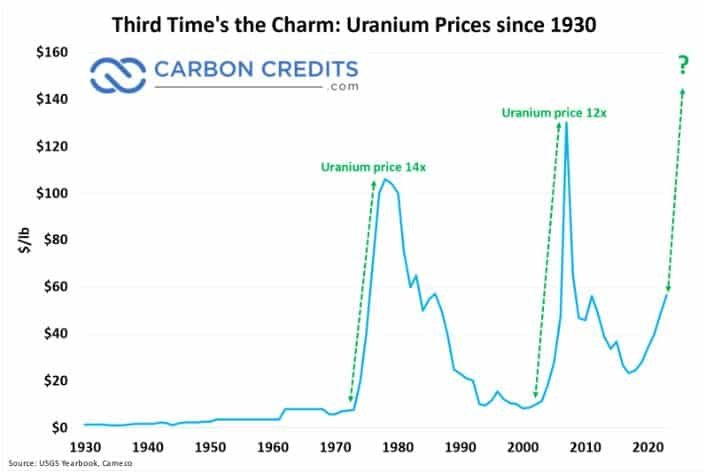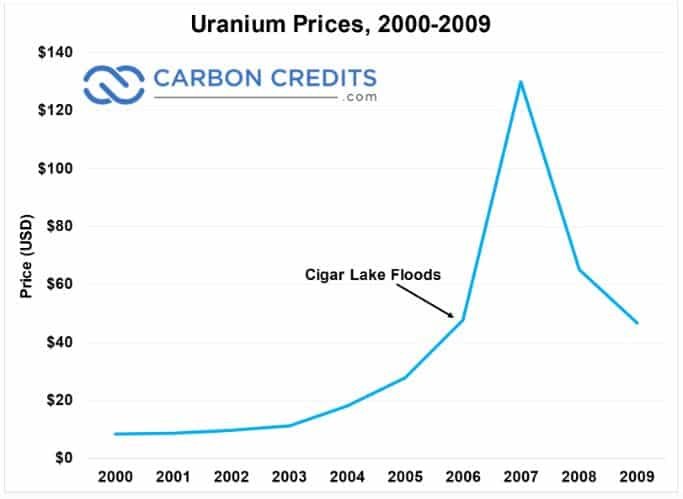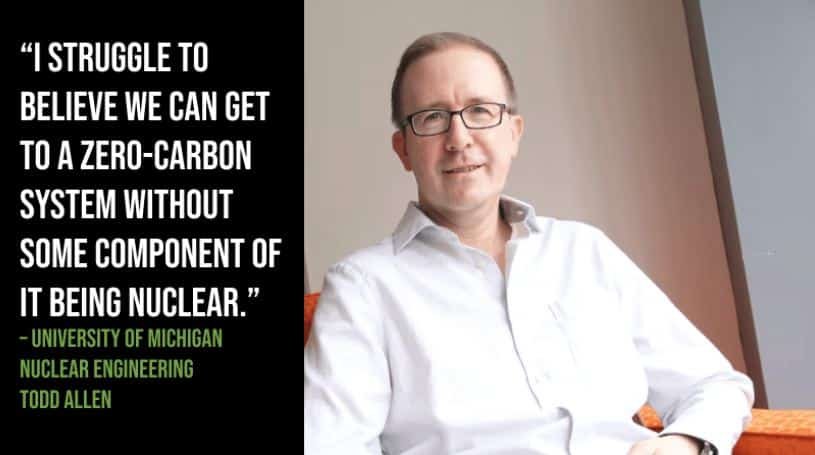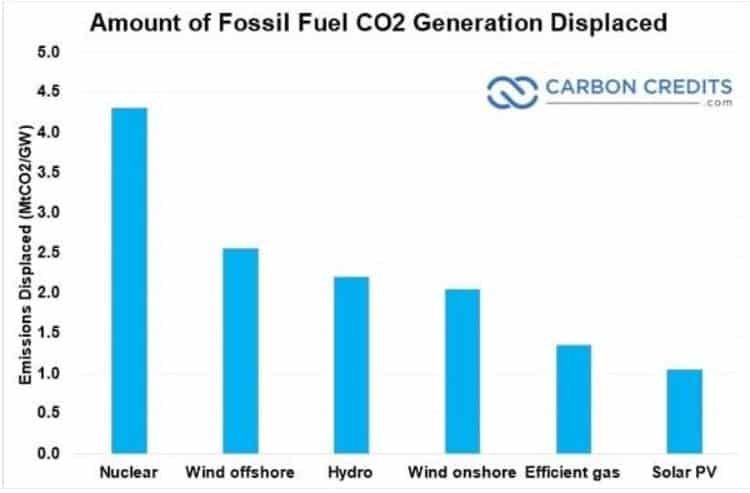Pricing provided by TradingView.
With its importance in the global energy landscape, the uranium price has become a hot topic for investors, policymakers, and energy enthusiasts. The world is evolving, and as technology advances, the need for efficient energy sources becomes paramount.
Among the plethora of energy resources, uranium stands out as a vital ingredient in nuclear power generation. Understanding the dynamics, factors affecting its prices, and potential future trends is essential for anyone keen on the energy sector.
Historical Trends in the Uranium Price
The history of uranium prices can be characterized as a roller-coaster ride. In the early days of nuclear energy, during the mid-20th century, there was an initial surge in demand. Prices peaked in the late 1970s, driven by energy crises and a burgeoning interest in nuclear power as a cleaner alternative to fossil fuels.
However, major incidents like the Chernobyl disaster in 1986 and the Fukushima Daiichi disaster in 2011, affected public perception of nuclear energy and its safety, causing significant dips in demand and consequently, prices.


But, as safety protocols improved and with the global push for cleaner energy, the value of uranium has seen a steady increase here in 2023.
Historic Uranium Price Spikes
Cigar Lake holds the largest reserve of high-grade uranium—at 100x average grade—anywhere in the world. And at the time it was supposed to be completed, it would have produced more than 10% of the world’s supply.
But when a small standpipe in Shaft No. 2 sprang a leak, two workers trying to fix it accidentally broke a valve completely off.
The gush of water couldn’t be stopped, and the mine flooded—several times. Mine development couldn’t resume for four years. The mere possibility of a tighter supply, combined with planned nuclear construction around the world, sent shockwaves through the entire uranium market.
The uranium price spiked from $20/lb. to $140/lb. in early 2007.


Cameco, the company that owns Cigar Lake, couldn’t have been happier with the payout. Despite its largest project—by far—having just been delayed by nearly a decade, Cameco’s stock rose by 300 percent from 2005–2007.
But ultra-high uranium prices led to historically high exploration and production… and the price began to return to normal. Then Fukushima happened in 2011, and it was Three Mile Island all over again.
As a result, the price fell to one of the lowest inflation-adjusted levels in history. And it stayed there.
Factors Influencing Uranium Prices
Several key elements play a role in determining the uranium price:
- Supply and Demand: Like any other commodity, uranium prices are heavily influenced by supply and demand dynamics. As more countries adopt nuclear power and existing nuclear plants expand, the demand for uranium increases. Meanwhile, supply constraints can arise from mining challenges, geopolitical issues, or strategic stockpiling.
- Production Costs: Mining uranium is capital intensive. The cost of production, influenced by factors like ore quality and extraction methods, has a direct bearing on its price. When the production cost is high, it can set a floor for uranium prices, as miners wouldn’t sell below their cost of production.
- Regulations and Policies: National and international regulations can sway uranium markets. Stringent safety and environmental guidelines can increase production costs, whereas supportive policies, such as those promoting clean energy, can boost demand.
- Alternative Energy Sources: The rise of renewables like solar and wind energy can influence uranium demand. While nuclear energy offers consistent power generation unlike some renewables, the growth of alternative energy sources can impact uranium’s market dynamics.
Uranium Price Future Outlook
Looking forward, several factors may influence the uranium price. One of the most significant is the role of nuclear energy in the global quest to combat climate change. This includes major corporate initiatives as well as government policy to reduce emissions.
As nations strive to reduce carbon emissions, nuclear power, despite its critics, presents a viable option for a consistent and large-scale energy source.
Emerging economies, particularly in Asia, are investing heavily in nuclear power. Countries like China and India, with their burgeoning populations and increasing energy needs, are looking towards nuclear energy to supplement their energy grids. This, in turn, will lead to a steady increase in demand for uranium in the coming years.
How High Can Uranium Prices Go?
According to Katusa Research, a distinct characteristic of the uranium market is its near-inelastic demand. Utility companies are compelled to purchase uranium for their reactors, irrespective of the uranium price.
- Even if uranium’s price shifts from $45 to $450 per pound, the change in cost per kilowatt-hour is minimal, especially when compared to equivalent price surges in natural gas or coal.
- To illustrate, if there’s a tenfold price hike in uranium, the cost for electricity generation from a nuclear reactor would only rise by about 24%.
Additionally, innovations in nuclear technology, including small modular reactors and next-generation reactors, might not only increase the efficiency of uranium usage but also boost its demand.
Uranium and the Acceleration of Nuclear Energy
The uranium price is more than just a number; it’s an indicator of the global energy landscape.


As the world grapples with the challenges of climate change and energy security, uranium will likely continue to play a significant role in the global energy mix.
- 440 nuclear power plants operating in 33 countries combined to provide 10% of the world’s electricity
- Globally, a total of 90 nuclear reactors are on order or planned, with over 300 more in the proposal stage.
- Nuclear energy will play a major role in the global energy mix as the world moves towards net zero emissions
The International Energy Agency says that the nuclear industry will need to double in size over the next two decades for us to meet net zero emissions targets.There are just over 400 nuclear reactors in operation around the world right now.
Future Uranium Price Dynamics: No Net Zero Without Nuclear
Far from reducing emissions—or even keeping them the same—for every reactor that is forced to shut down, CO2 emissions rise by 5.8 MT a year. That’s the equivalent of filling an NFL stadium to the brim with gas, and setting it on fire.
We’d need to install solar panels on one million homes just to make up for shuttering a single reactor. Nuclear reactors are extremely efficient, low-carbon sources of energy. In fact, it doesn’t matter whether it’s replacing coal or natural gas:
- Nuclear is nearly 100 percent more effective than any other energy technology at reducing CO2 emissions.


There is simply no achieving net zero without nuclear. Staying informed about its price trends and underlying factors can offer insights not just into the nuclear energy sector, but the broader trajectory of our global energy future.
- SEO Powered Content & PR Distribution. Get Amplified Today.
- PlatoData.Network Vertical Generative Ai. Empower Yourself. Access Here.
- PlatoAiStream. Web3 Intelligence. Knowledge Amplified. Access Here.
- PlatoESG. Automotive / EVs, Carbon, CleanTech, Energy, Environment, Solar, Waste Management. Access Here.
- PlatoHealth. Biotech and Clinical Trials Intelligence. Access Here.
- ChartPrime. Elevate your Trading Game with ChartPrime. Access Here.
- BlockOffsets. Modernizing Environmental Offset Ownership. Access Here.
- Source: https://carboncredits.com/uranium-price-guide-trends-factors-and-future-predictions/



